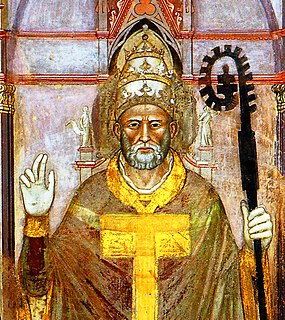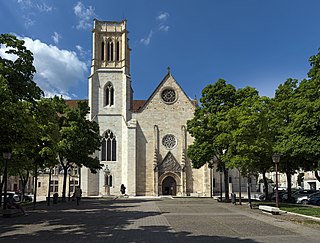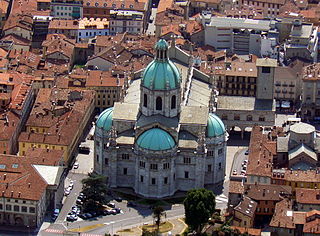Related Research Articles

Pope Benedict XI, born Nicola Boccasini, was head of the Catholic Church and ruler of the Papal States from 22 October 1303 to his death in 7 July 1304.

Pope Urban V, born Guillaume de Grimoard, was the head of the Catholic Church from 28 September 1362 until his death in December 1370 and was also a member of the Order of Saint Benedict. He was the only Avignon pope to be beatified.

Pope Innocent VI, born Étienne Aubert, was head of the Catholic Church and ruler of the Papal States from 18 December 1352 to his death in September 1362. He was the fifth Avignon pope and the only one with the pontifical name of "Innocent".

The Diocese of Agen is a Latin Church ecclesiastical territory or diocese of the Catholic Church in France.
The diocese of Bagnoregio is a former Roman Catholic territory, located in the modern Province of Viterbo in the Italian region of Lazio, located about 90 kilometres (56 mi) northwest of Rome. Prior to the creation of the Kingdom of Italy, it belonged to the Papal States, and was located in the region of Umbria. It had been given to the Papal States by the Emperor Louis I in 822. In terms of religious administration, it was directly dependent upon the Holy See (Papacy). The pope appointed an Apostolic Administrator for the diocese of Bagnoregio on 8 June 1970, and the bishop was not replaced when he died in 1971. The diocese was suppressed on 30 September 1986 by Pope John Paul II.

The Italian Catholic metropolitan Archdiocese of Benevento has a long history; it now has five suffragan dioceses: the diocese of Ariano Irpino-Lacedonia, the diocese of Avellino, the diocese of Cerreto Sannita-Telese-Sant'Agata de' Goti, the Territorial Abbey of Montevergine, and the archdiocese of Sant'Angelo dei Lombardi-Conza-Nusco-Bisaccia.

Hélie de Talleyrand-Périgord was a French Cardinal, from one of the most aristocratic families in Périgord, south-west France. Hélie was born at Périgueux, third son of Elias VII, Count of Périgord, and Brunissende of Foix, daughter of Roger Bernard III, comte de Foix. His elder brothers were Archambaud (IV), who inherited the County, and Roger-Bernard ; his younger brother was Fortanier, and his sisters were Agnes, Jeanne, Marguerite, and Rosemburge. As a third son Hélie was destined for an ecclesiastical career. His brother, Roger Bernard, too, had an ecclesiastical career, becoming Canon of Lyon. But then, the eldest son died, and Roger-Bernard became the Count of Périgord. Hélie became a major figure in the Avignon papacy, and also a diplomat engaged in the negotiations of the Hundred Years' War, having friendships in both English and French royal families. In his last months he had been appointed Papal Legate for a crusade against the Turks.

The bishopric of Lavaur was founded by Pope John XXII in his plan to reorganize the sprawling diocese of Toulouse. The town is situated some fifteen miles to the east of Toulouse. Lavaur had the reputation of being one of the strongest centers of Catharism, being referred to as sedes Satanae, atque erroris haeretici primatica ('seat of Satan and prime source of heretical error' The diocese consisted of some 80–90 parishes. It hosted one abbey, that of Sorèz, a convent of the Clarisses, a convent of the Daughters of the Cross, a convent of Dominicans, one of Franciscans, one of Capuchins, two of reformed Dominicans, and two houses of the Doctrinaires. The diocese produced some 35,000 livres for the bishop.

The Roman Catholic Archdiocese of Poitiers is an archdiocese of the Latin Rite of the Catholic Church in France. The archepiscopal see is in the city of Poitiers. The Diocese of Poitiers includes the two Departments of Vienne and Deux-Sèvres. The Concordat of 1802 added to the see besides the ancient Diocese of Poitiers a part of the Diocese of La Rochelle and Saintes.
Adam de Lanark, O.P. was a 14th-century Scottish Dominican friar and prelate. Possibly from a Lanark burgess family, he was a Dominican and a priest by 1356, and by 1364 was styled Magister, indicating the completion of a long university education. He first appears in the sources, c. 1355/6 as a confessor of King David II of Scotland; he retained this royal position through the 1350s and into the 1360s; Adam received a number of English safe-conducts to visit King David, who for a time was a prisoner in England.

The Roman Catholic Archdiocese of Albi (–Castres–Lavaur), usually referred to simply as the Archdiocese of Albi, is a non-metropolitan archdiocese of the Latin Rite of the Catholic Church in southern France. The archdiocese comprises the whole of the department of Tarn, and has itself been suffragan, since the 2002 provinces reform, to the Archdiocese of Toulouse, a metropolitan archdiocese.

The Roman Catholic Archdiocese of Clermont is an archdiocese of the Latin Rite of the Roman Catholic Church in France. The diocese comprises the department of Puy-de-Dôme, in the Region of Auvergne. The Archbishop's seat is Clermont-Ferrand Cathedral. Throughout its history Clermont was the senior suffragan of the Archdiocese of Bourges. It became a metropolitan see itself, however, in 2002. The current archbishop is François Kalist.

The Roman Catholic Diocese of Montauban is a diocese of the Latin Rite of the Roman Catholic Church in France. The diocese is coextensive with Tarn-et-Garonne, and is currently a suffragan of the Archdiocese of Toulouse. The episcopal seat of the Diocese of Montauban is in Montauban Cathedral.

The Diocese of Como is a Latin Church ecclesiastical jurisdiction or diocese of the Catholic Church in northern Italy. It was established in the Fourth Century. It is a suffragan diocese in the ecclesiastical province of the metropolitan Archdiocese of Milan. The Bishop of Como's cathedra is in the Como Cathedral.

The Roman Catholic Archdiocese of Ferrara-Comacchio has existed since 1986, when the diocese of Comacchio was combined with the historical archdiocese of Ferrara. It is a suffragan of the archdiocese of Bologna.
The Latin Catholic Diocese of Muro Lucano, in the southern Italian region of Basilicata, existed until 1986. In that year it was united into the archdiocese of Potenza-Muro Lucano-Marsico Nuovo.

The Diocese of Anagni-Alatri is a Latin Church ecclesiastical territory or diocese of the Catholic Church in Lazio, Italy. It has existed in its current form since 1986. In that year the Diocese of Alatri was united to the historical Diocese of Anagni. The diocese is immediately exempt to the Holy See.

Audouin Aubert was a French jurist, bishop and Cardinal.

Adolph III of the Marck was the Prince-Bishop of Münster from 1357 to 1363, the Archbishop-Elector of Cologne in 1363, the Count of Cleves from 1368 to 1394, and the Count of Mark from 1391 to 1393.
Thomas de Ringstead was an English Dominican who became Bishop of Bangor.
References
- ↑ P. Nitecki, Biskupi Kościoła w Polsce. in latach 965-1999. Słownik biograficzny, Warszawa, Instytut Wydawniczy PAX, 2000, ISBN 83-211-1311-7, pp. 27-28.
- ↑ J. Wyrozumski, Kazimierz Wielki, wyd. 2, Wrocław 1986, ISBN 83-04-01041-0, pp. 124-125.